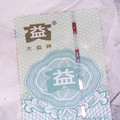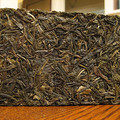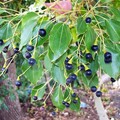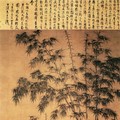Pu-erh tea
„Pu-erh tea, also spelled as Pu'er tea, is a variety of fermented dark tea produced in Yunnan province, China.“
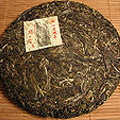
„Fermentation is a tea production style in which the tea leaves undergo microbial fermentation and oxidation after they are dried and rolled. This process is a Chinese specialty and produces tea known as Hei Cha (黑茶), commonly translated to dark, or black tea (this type of tea is completely different from what in West is known as "black tea", which in China is called "red tea"). “

Quotes Tags: Pu-erh, Tea oxidation, Hei Cha
„The most famous variety of this category of tea is Pu-erh from Yunnan Province, named after the trading post for dark tea during imperial China.“

Quotes Tags: Pu-erh
„Pu'er traditionally begins as a raw product known as "rough" Mao Cha (毛茶) and can be sold in this form or pressed into a number of shapes and sold as "raw" Sheng Cha (生茶). Both of these forms then undergo the complex process of gradual fermentation and maturation with time.“

Quotes Tags: Pu-erh, Sheng - Raw Puerh, Maocha
„The recently developed Wo Dui process (渥堆) pioneered by both the Menghai and Kunming Tea Factories has created a new type of pu-erh tea of which some traditionalists dispute the legitimacy. This process involves an accelerated fermentation into "ripe" Shou Cha (熟茶) which is then sold loose or pressed in various shapes.“

Quotes Tags: Pu-erh, Shu - Ripe Puerh
„All types or pu-erh can be stored for maturity before consumption and that is why it has become common for the products to be labelled with year and region of production.“

Quotes Tags: Pu-erh
„Wo Dui - this new process produced a finished product in a manner of months that many thought tasted similar to teas aged naturally for 10–15 years and so this period saw a demand-driven boom in the production of Hei Cha by the artificial ripening method. “

Quotes Tags: Pu-erh, Shu - Ripe Puerh
„In recent decades, demand has come full circle and it has become more common again for Hei Cha, including Pu-erh, to be sold as the raw product without the artificial accelerated fermentation process.“

Quotes Tags: Pu-erh, Sheng - Raw Puerh
„Pu-erh tea processing, although straightforward, is complicated by the fact that the tea itself falls into two distinct categories: the "raw" Sheng Cha and the "ripe" Shou Cha. All types of pu-erh tea are created from máochá (毛茶), a mostly unoxidized green tea processed from a "large leaf" variety of Camellia sinensis (C. sinensis assamica) found in the mountains of southern Yunnan.“

Quotes Tags: Pu-erh, Tea oxidation, Yunnan, Sheng - Raw Puerh, Shu - Ripe Puerh
„Maocha can be sold directly to market as loose leaf tea, compressed to produce "raw" Sheng Cha, naturally aged and matured for several year before being compressed to also produce "raw" Sheng Cha or undergo Wo Dui ripening for several months prior to being compressed to produce "ripe" Shou Cha.“

Quotes Tags: Pu-erh, Sheng - Raw Puerh, Shu - Ripe Puerh, Maocha
„While unaged and unprocessed, Maocha pu-erh is similar to green tea. Two subtle differences worth noting are that pu-erh is not produced from the small leaf chinese varietal but the broad leaf varietal mostly found in the southern Chinese Provinces and India.“

„Pu-erh leaves are picked as one bud and 3-4 leaves whilst green tea is picked as one bud and 1-2 leaves. This means that older leaves contribute to the qualities of pu-erh tea.“

Quotes Tags: Pu-erh
„Ripened or aged raw pu-erh has occasionally been mistakenly categorised as a subcategory of black tea due to the dark red colour of its leaves and liquor. However, pu-erh in both its ripened and aged forms has undergone secondary oxidization and fermentation caused both by organisms growing in the tea and free-radical oxidation, thus making it a unique type of tea. This divergence in production style not only makes the flavour and texture of pu-erh tea different but also results in a rather different chemical makeup to resulting brewed liquor.“

Quotes Tags: Pu-erh, Tea oxidation, Sheng - Raw Puerh, Shu - Ripe Puerh
„The fermented dark tea, Hei Cha (黑茶), is one of the six classes of tea in China, and pu-erh is classified as a dark tea (defined as fermented), something which is resented by some who argue for a separate category for pu-erh tea.“

„Pu-erh is typically made through the following steps:
1. green/raw 青普: sun fixation 曬青 > rolling 揉捻 > sun drying 曬乾:
2. dark/ripe 熟普: sun fixation 曬青 > rolling 揉捻 > Wo Dui (piling) 渥堆 > sun drying 曬乾:
3. added processes: green and dark pu'er can be compressed/shaped into cakes and aged.“

Quotes Tags: Pu-erh, Sheng - Raw Puerh, Shu - Ripe Puerh, Tea production
„After picking appropriate tender leaves, the first step in making raw or ripened pu'er is an optional wilting/withering stage, thus converting the leaf to maocha.“

Quotes Tags: Pu-erh, Sheng - Raw Puerh, Shu - Ripe Puerh, Maocha
„The leaves are then dry pan-fried using a large wok in a process called "kill green" (殺青; pinyin: shā qīng), which arrests most enzyme activity in the leaf and prevents full oxidation. After pan-frying, the leaves are rolled, rubbed, and shaped into strands through several steps to lightly bruise the tea and then left to dry in the sun.“

Quotes Tags: Pu-erh, Tea oxidation
„Unlike green tea produced in china which is dried with hot air after the pan-frying stage to completely kill enzyme activity, leaves used in the production of pu-erh are only pan-fried and thus a small amount of enyzmes are left which contribute a minor amount of oxidation to the leaves during sun-drying“

Quotes Tags: Pu-erh, Tea oxidation
„Once dry, maocha can be sent directly to the factory to be pressed into raw pu'er, or to undergo further processing to make ripened pu'er. Sometimes Mao Cha is sold directly as loose-leaf "raw" Sheng Cha or it can be matured for 2–3 years in loose leaf form due to the faster rate of natural fermentation in an uncompressed state. This product is then pressed into numerous shapes and sold as "raw" Sheng Cha as a more matured final product.“

Quotes Tags: Pu-erh, Sheng - Raw Puerh, Maocha
„‘Ripened’ Shou Cha (熟茶) tea is pressed maocha that has been specially processed to imitate aged "raw" Sheng Cha tea. Although it is also known as cooked pu-erh, the process does not actually employ cooking to imitate the aging process. The term may come about due to inaccurate translation due to the dual meaning of shú (熟) as both "fully cooked" and "fully ripened".“

Quotes Tags: Pu-erh, Sheng - Raw Puerh, Shu - Ripe Puerh, Maocha
„The process used to convert máochá into ripened pu'er is a recent invention that manipulates conditions to approximate the result of the aging process by prolonged bacterial and fungal fermentation in a warm humid environment under controlled conditions, a technique called Wò Dūi (渥堆, "wet piling" in English), which involves piling, dampening, and turning the tea leaves in a manner much akin to composting.“

Quotes Tags: Pu-erh, Shu - Ripe Puerh
„The piling, wetting, and mixing of the piled máochá ensures even fermentation. The bacterial and fungal cultures found in the fermenting piles were found to vary widely from factory to factory throughout Yunnan, consisting of multiple strains of Aspergillus spp., Penicillium spp., yeasts, and a wide range of other microflora. Control over the multiple variables in the ripening process, particularly humidity and the growth of Aspergillus spp., is key in producing ripened pu'er of high quality.“

Quotes Tags: Pu-erh, Yunnan, Shu - Ripe Puerh
„Poor control in fermentation/oxidation process can result in bad ripened pu'er, characterized by badly decomposed leaves and an aroma and texture reminiscent of compost.“

Quotes Tags: Pu-erh, Tea oxidation, Shu - Ripe Puerh
„This process was first developed in 1972 by Menghai Tea Factory and Kunming Tea Factory] to imitate the flavor and colour of aged raw pu-erh, and was an adaptation of wet storage techniques being used by merchants to falsify the age of their teas. Mass production of ripened pu'er began in 1975. It can be consumed without further aging, though it can also be stored to "air out" some of the less savoury flavors and aromas acquired during fermentation.“

Quotes Tags: Pu-erh, Shu - Ripe Puerh
„Some tea collectors believe "ripened" Sheng Cha should not be aged for more than a decade.“

Quotes Tags: Pu-erh, Shu - Ripe Puerh
„To produce pu'er, many additional steps are needed prior to the actual pressing of the tea. First, a specific quantity of dry máochá or ripened tea leaves pertaining to the final weight of the bingcha is weighed out. The dry tea is then lightly steamed in perforated cans to soften and make it more tacky. This will allow it to hold together and not crumble during compression. “

Quotes Tags: Pu-erh
„Depending on the desired product and speed, from quickest and tightest to slowest and loosest, pressing can be done by a hydraulic press, which forces the tea into a metal form that is occasionally decorated with a motif in sunken-relief. Due to its efficiency, this method is used to make almost all forms of pressed pu'er.“

Quotes Tags: Pu-erh
„Depending on the desired product and speed, from quickest and tightest to slowest and loosest, pressing can be done by a lever press, which was operated by hand for tight pressings and has largely been replaced by the modern hydraulic press.“

Quotes Tags: Pu-erh
„Depending on the desired product and speed, from quickest and tightest to slowest and loosest, pressing can be done by a large heavy stone, carved into the shape of a short cylinder with a handle, simply weighs a bag of tea down onto a wooden board. The tension from the bag and the weight of the stone together give the tea its rounded and sometimes non-uniformed edge. Due to the manual labor involved, this method of pressing is often referred to as: "hand" or "stone-pressing", and is how many artisanal pu'er bǐng are still manufactured.“

Quotes Tags: Pu-erh
„Aside from vintage year, pu'er tea can be classified in a variety of ways: by shape, processing method, region, cultivation, grade, and season.“

Quotes Tags: Pu-erh
„Wrapper: Made usually from thin cotton cloth or cotton paper and shows the tea company/factory, the year of production, the region/mountain of harvest, the plant type, and the recipe number. The wrapper can also contain decals, logos and artwork. Occasionally, more than one wrapper will be used to wrap a pu'er cake.“
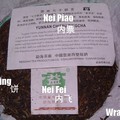
Quotes Tags: Pu-erh
„Nèi fēi (内飞 or 內飛): A small ticket originally stuck on the tea cake but now usually embedded into the cake during pressing. It is usually used as proof, or a possible sign, to the authenticity of the tea. Some higher end pu'er cakes have more than one nèi fēi embedded in the cake. The ticket usually indicates the tea factory and brand.“

„Nèi piào (内票): A larger description ticket or flyer packaged loose under the wrapper. Both aid in assuring the identity of the cake. It usually indicates factory and brand. As well, many nèi piào contain a summary of the tea factories' history and any additional laudatory statements concerning the tea, from its taste and rarity, to its ability to cure diseases and effect weight loss.“

„Bĭng: The tea cake itself. Tea cakes or other compressed pu'er can be made up of two or more grades of tea, typically with higher grade leaves on the outside of the cake and lower grades or broken leaves in the center. This is done to improve the appearance of the tea cake and improve its sale. Predicting the grade of tea used on the inside takes some effort and experience in selection. However, the area in and around the dimple of the tea cake can sometimes reveal the quality of the inner leaves.“

Theme
Tea by region
We will help you with tea selection.
Do you like quality loose tea?
We will help you to find the right one for you. Be inspired by tea ratings of other tea lovers. Rating stars could help you.


Review your cup of tea.
Review the tea you are drinking and help other tea lovers to find the right cup of tea.



Teas
Darjeeling Jungpana Wonder Delight Second
 1 review
1 reviewBeautifully prepared whole leaf tea cultivar Pb312. Very rare tea from this garden, production only 9kg.
2013 Spring Mengsong Baotang Gushu Maocha
 1 review
1 reviewMengsong is one of the oldest ancient tea area in Menghai. Baotang old village is located next to the...
2013 White 2 Tea New Amerykah
 2 reviews
2 reviewsThis puer tea cake is made from a 2013 pure Spring blend of gushu [old tree] material from the Menghai...
Quotes
„Tea learning is, at the end of the day, a solitary experience. No one knows what you’re tasting, so no one but you can teach yourself.“



 Shops
Shops Share on Facebook
Share on Facebook



